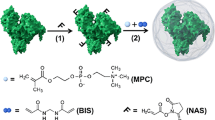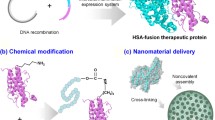Abstract
Protein therapy, wherein therapeutic proteins are delivered to treat disorders, is considered the safest and most direct approach for treating diseases. However, its applications are highly limited by the paucity of efficient strategies for delivering proteins and the rapid clearance of therapeutic proteins in vivo after their administration. Here, we demonstrate a novel strategy that can significantly prolong the circulation time of therapeutic proteins as well as minimize their immunogenicity. This is achieved by encapsulating individual protein molecules with a thin layer of crosslinked phosphorylcholine polymer that resists protein adsorption. Through extensive cellular studies, we demonstrate that the crosslinked phosphorylcholine polymer shell effectively prevents the encapsulated protein from being phagocytosed by macrophages, which play an essential role in the clearance of nanoparticles in vivo. Moreover, the polymer shell prevents the encapsulated protein from being identified by immune cells. As a result, immune responses against the therapeutic protein are effectively suppressed. This work describes a feasible method to prolong the circulation time and reduce the immunogenicity of therapeutic proteins, which may promote the development and application of novel protein therapies in the treatment of diverse diseases.

Similar content being viewed by others
References
Leader, B.; Baca, Q. J.; Golan, D. E. Protein therapeutics: A summary and pharmacological classification. Nat. Rev. Drug Discov. 2008, 7, 21–39.
Krejsa, C.; Rogge, M.; Sadee, W. Protein therapeutics: New applications for pharmacogenetics. Nat. Rev. Drug Discov. 2006, 5, 507–521.
Christian, D. A.; Cai, S. S.; Bowen, D. M.; Kim, Y.; Pajerowski, J. D.; Discher, D. E. Polymersome carriers: From self-assembly to siRNA and protein therapeutics. Eur. J. Pharm. Biopharm. 2009, 71, 463–474.
Baker, M.; Reynolds, H. M.; Lumicisi, B.; Bryson, C. J. Immunogenicity of protein therapeutics: The key causes, consequences and challenges. Self/Nonself 2010, 1, 314–322.
Manning, M. C.; Chou, D. K.; Murphy, B. M.; Payne, R. W.; Katayama, D. S. Stability of protein pharmaceuticals: An update. Pharm. Res. 2010, 27, 544–575.
Manning, M. C.; Patel, K.; Borchardt, R. T. Stability of protein pharmaceuticals. Pharm. Res. 1989, 6, 903–918.
Albanese, A.; Tang, P. S.; Chan, W. C. W. The effect of nanoparticle size, shape, and surface chemistry on biological systems. Annu. Rev. Biomed. Eng. 2012, 14, 1–16.
Moghimi, S. M.; Hunter, A. C.; Murray, J. C. Long-circulating and target-specific nanoparticles: Theory to practice. Pharmacol. Rev. 2001, 53, 283–318.
Pisal, D. S.; Kosloski, M. P.; Balu-Iyer, S. V. Delivery of therapeutic proteins. J. Pharm. Sci. 2010, 99, 2557–2575.
Harris, J. M.; Chess, R. B. Effect of pegylation on pharmaceuticals. Nat. Rev. Drug Discov. 2003, 2, 214–221.
Knop, K.; Hoogenboom, R.; Fischer, D.; Schubert, U. S. Poly(ethylene glycol) in drug delivery: Pros and cons as well as potential alternatives. Angew. Chem., Int. Ed. 2010, 49, 6288–6308.
Harris, J. M.; Veronese, F. M. Peptide and protein pegylation II-clinical evaluation. Adv. Drug Deliv. Rev. 2003, 55, 1259–1260.
Armstrong, J. K.; Hempel, G.; Koling, S.; Chan, L. S.; Fisher, T.; Meiselman, H. J.; Garratty, G. Antibody against poly(ethylene glycol) adversely affects PEG-asparaginase therapy in acute lymphoblastic leukemia patients. Cancer 2007, 110, 103–111.
Veronese, F. M. Peptide and protein PEGylation: A review of problems and solutions. Biomaterials 2001, 22, 405–417.
Ishihara, T.; Takeda, M.; Sakamoto, H.; Kimoto, A.; Kobayashi, C.; Takasaki, N.; Yuki, K.; Tanaka, K.; Takenaga, M.; Igarashi, R. et al. Accelerated blood clearance phenomenon upon repeated injection of PEG-modified PLA-nanoparticles. Pharm. Res. 2009, 26, 2270–2279.
Ishihara, K.; Oshida, H.; Endo, Y.; Ueda, T.; Watanabe, A.; Nakabayashi, N. Hemocompatibility of human whole blood on polymers with a phospholipid polar group and its mechanism. J. Biomed. Mater. Res. 1992, 26, 1543–1552.
Ishihara, K.; Nomura, H.; Mihara, T.; Kurita, K.; Iwasaki, Y.; Nakabayashi, N. Why do phospholipid polymers reduce protein adsorption? J. Biomed. Mater. Res. 1998, 39, 323–330.
Zhang, L.; Cao, Z. Q.; Bai, T.; Carr, L.; Ella-Menye, J.-R.; Irvin, C.; Ratner, B. D.; Jiang, S. Y. Zwitterionic hydrogels implanted in mice resist the foreign-body reaction. Nat. Biotechnol. 2013, 31, 553–556.
Lowe, A. B.; McCormick, C. L. Synthesis and solution properties of zwitterionic polymers. Chem. Rev. 2002, 102, 4177–4190.
Zhang, Z.; Chen, S. F.; Chang, Y.; Jiang, S. Y. Surface grafted sulfobetaine polymers via atom transfer radical polymerization as superlow fouling coatings. J. Phys. Chem. B 2006, 110, 10799–10804.
Zhang, Z.; Vaisocherová, H.; Cheng, G.; Yang, W.; Xue, H.; Jiang, S. Y. Nonfouling behavior of polycarboxybetainegrafted surfaces: Structural and environmental effects. Biomacromolecules 2008, 9, 2686–2692.
Vaisocherová, H.; Yang, W.; Zhang, Z.; Cao, Z. Q.; Cheng, G.; Piliarik, M.; Homola, J.; Jiang, S. Y. Ultralow fouling and functionalizable surface chemistry based on a zwitterionic polymer enabling sensitive and specific protein detection in undiluted blood plasma. Anal. Chem. 2008, 80, 7894–7901.
Jiang, S. Y.; Cao, Z. Q. Ultralow-fouling, functionalizable, and hydrolyzable zwitterionic materials and their derivatives for biological applications. Adv. Mater. 2010, 22, 920–932.
Chen, S. F.; Zheng, J.; Li, L. Y.; Jiang, S. Y. Strong resistance of phosphorylcholine self-assembled monolayers to protein adsorption: Insights into nonfouling properties of zwitterionic materials. J. Am. Chem. Soc. 2005, 127, 14473–14478.
He, Y.; Hower, J.; Chen, S. F.; Bernards, M. T.; Chang, Y.; Jiang, S. Y. Molecular simulation studies of protein interactions with zwitterionic phosphorylcholine self-assembled monolayers in the presence of water. Langmuir 2008, 24, 10358–10364.
Iwasaki, Y.; Ishihara, K. Phosphorylcholine-containing polymers for biomedical applications. Anal. Bioanal. Chem. 2005, 381, 534–546.
Matsuno, R.; Ishihara, K. Integrated functional nanocolloids covered with artificial cell membranes for biomedical applications. Nano Today 2011, 6, 61–74.
Matsuno, R.; Ishihara, K. Molecular-integrated phospholipid polymer nanoparticles with highly biofunctionality. Macromol. Symp. 2009, 279, 125–131.
Zhu, Y. H.; Sundaram, H. S.; Liu, S. J.; Zhang, L.; Xu, X. W.; Yu, Q. M.; Xu, J. Q.; Jiang, S. Y. A robust graft-to strategy to form multifunctional and stealth zwitterionic polymercoated mesoporous silica nanoparticles. Biomacromolecules 2014, 15, 1845–1851.
Liu, J. B.; Yu, M. X.; Ning, X. H.; Zhou, C.; Yang, S. Y.; Zheng, J. PEGylation and zwitterionization: Pros and cons in the renal clearance and tumor targeting of near-IRemitting gold nanoparticles. Angew. Chem., Int. Ed. 2013, 52, 12572–12576.
Liu, P. S.; Skelly, J. D.; Song, J. Three-dimensionally presented anti-fouling zwitterionic motifs sequester and enable highefficiency delivery of therapeutic proteins. Acta Biomater. 2014, 10, 4296–4303.
Lewis, A.; Tang, Y. Q.; Brocchini, S.; Choi, J. W.; Godwin, A. Poly(2-methacryloyloxyethyl phosphorylcholine) for protein conjugation. Bioconjug. Chem. 2008, 19, 2144–2155.
Keefe, A. J.; Jiang, S. Y. Poly(zwitterionic)protein conjugates offer increased stability without sacrificing binding affinity or bioactivity. Nat. Chem. 2012, 4, 59–63.
Romberg, B.; Hennink, W. E.; Storm, G. Sheddable coatings for long-circulating nanoparticles. Pharm. Res. 2008, 25, 55–71.
Mastrobattista, E.; van der Aa, M. A. E. M.; Hennink, W. E.; Crommelin, D. J. A. Artificial viruses: A nanotechnological approach to gene delivery. Nat. Rev. Drug Discov. 2006, 5, 115–121.
Yang, W.; Liu, S. J.; Bai, T.; Keefe, A. J.; Zhang, L.; Ella-Menye, J.-R.; Li, Y. T.; Jiang, S. Y. Poly(carboxybetaine) nanomaterials enable long circulation and prevent polymerspecific antibody production. Nano Today 2014, 9, 10–16.
Bertrand, N.; Leroux, J.-C. The journey of a drug-carrier in the body: An anatomo-physiological perspective. J. Control. Release 2012, 161, 152–163.
Champion, J. A.; Katare, Y. K.; Mitragotri, S. Particle shape: A new design parameter for micro- and nanoscale drug delivery carriers. J. Controlled Release 2007, 121, 3–9.
Ruddy, S.; Gigli, I.; Austen, K. F. The complement system of man. N. Engl. J. Med. 1972, 287, 489–495.
Müller-Eberhard, H. J. Molecular organization and function of the complement system. Annu. Rev. Biochem. 1988, 57, 321–347.
Yan, M.; Du, J. J.; Gu, Z.; Liang, M.; Hu, Y. F.; Zhang, W. J.; Priceman, S.; Wu, L.; Zhou, Z. H.; Liu, Z. et al. A novel intracellular protein delivery platform based on singleprotein nanocapsules. Nat. Nanotechnol. 2010, 5, 48–53.
Liu, Y.; Du, J. J.; Yan, M.; Lau, M. Y.; Hu, J.; Han, H.; Yang, O. O.; Liang, S.; Wei, W.; Wang, H. et al. Biomimetic enzyme nanocomplexes and their use as antidotes and preventive measures for alcohol intoxication. Nat. Nanotechnol. 2013, 8, 187–192.
Delves, P. J.; Martin, S. J.; Burton, D. R.; Roitt, I. M. Roitt’s Essential Immunology; Wiley-Blackwell: New York, 2011.
Petros, R. A.; DeSimone, J. M. Strategies in the design of nanoparticles for therapeutic applications. Nat. Rev. Drug Discov. 2010, 9, 615–627.
Dancey, J. E.; Chen, H. X. Strategies for optimizing combinations of molecularly targeted anticancer agents. Nat. Rev. Drug Discov. 2006, 5, 649–659.
Schlesinger, N.; Yasothan, U.; Kirkpatrick, P. Pegloticase. Nat. Rev. Drug Discov. 2011, 10, 17–18.
Vockley, J.; Andersson, H. C.; Antshel, K. M.; Braverman, N. E.; Burton, B. K.; Frazier, D. M.; Mitchell, J.; Smith, W. E.; Thompson, B. H.; Berry, S. A. Phenylalanine hydroxylase deficiency: Diagnosis and management guideline. Genet. Med. 2014, 16, 188–200.
Pieters, R.; Hunger, S. P.; Boos, J.; Rizzari, C.; Silverman, L.; Baruchel, A.; Goekbuget, N.; Schrappe, M.; Pui, C.-H. L-asparaginase treatment in acute lymphoblastic leukemia. Cancer 2011, 117, 238–249.
Appel, I. M.; Kazemier, K. M.; Boos, J.; Lanvers, C.; Huijmans, J.; Veerman, A. J. P.; van Wering, E.; den Boer, M. L.; Pieters, R. Pharmacokinetic, pharmacodynamic and intracellular effects of PEG-asparaginase in newly diagnosed childhood acute lymphoblastic leukemia: Results from a single agent window study. Leukemia 2008, 22, 1665–1679.
Rytting, M. Peg-asparaginase for acute lymphoblastic leukemia. Expert Opin. Biol. Ther. 2010, 10, 833–839.
Author information
Authors and Affiliations
Corresponding authors
Additional information
These authors contributed equally to this work.
Electronic supplementary material
Rights and permissions
About this article
Cite this article
Liang, S., Liu, Y., Jin, X. et al. Phosphorylcholine polymer nanocapsules prolong the circulation time and reduce the immunogenicity of therapeutic proteins. Nano Res. 9, 1022–1031 (2016). https://doi.org/10.1007/s12274-016-0991-3
Received:
Revised:
Accepted:
Published:
Issue Date:
DOI: https://doi.org/10.1007/s12274-016-0991-3




